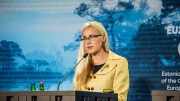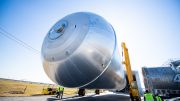The recipe for independence from Russian gas is the acceleration of the clean energy transition; its success depends on the use of the right ingredients, write Megan Anderson, Bram Claeys and Jan Rosenow.
Megan Anderson is an associate at the Regulatory Assistance Project (RAP), an independent organisation promoting the transition to clean energy. Bram Claeys is senior advisor at RAP, and Jan Rosenow is principal and European programme director at RAP.
With its recent REPowerEU communication, the European Commission sets forth a laudable goal of ‘rapidly reducing our dependence on Russian fossil fuels by fast-forwarding the clean transition.’
The Commission rightly proposes a clean energy policy recipe as the most effective way to reduce gas import dependency. But does the recipe contain the right ingredients?
Energy efficiency and renewable energy are the right base
The main ingredients in a clean energy transition are energy efficiency, which reduces overall energy demand and increases system flexibility, and clean energy resources.
The REPowerEU proposals provide for both: The proposal increases the energy efficiency target in the Energy Efficiency Directive from 9% of EU energy consumption to 13% by 2030 compared to the reference scenario.
And the Commission expands the target for renewable energy to 45% by 2030, up 5% from last year’s proposal. This increase would result in 1,236 GW of renewable energy generation capacity, as compared to Fit For 55’s expectation of 1,067 GW by 2030, with even more rapid increases for solar deployment.
The Commission’s proposals in this regard are in line with its own conclusion that accelerating the greater deployment of renewable energy will reduce electricity prices and decrease fossil fuel imports.
Specific measures to reduce fossil gas use for heating include an early phase-out of fossil fuel heating system subsidies by 2025, more ambitious minimum energy performance standards, and a proposal to use the Ecodesign Directive to ban stand-alone fossil fuel heating systems.
In short, REPowerEU includes sound proposals to facilitate an accelerated clean energy transition and increased energy independence.
Hydrogen is the frosting, not the whole cake
In addition to increasing renewable energy and energy efficiency targets, REPowerEU proposes massive increases in green hydrogen and biomethane, thus emphasizing these options as key solutions to replace fossil fuels.
To fit within the recipe for a clean energy transition, however, these elements must be produced with renewable fuels and used only to augment the other ingredients. Failing to include limitations on these pieces throws REPowerEU off course.
The Commission proposes to accelerate renewable hydrogen deployment within Europe to 10 million tonnes and imports of additional 10 million tonnes per year. Current global green hydrogen production is less than 1 million tonnes per year.
Whilst expanded green hydrogen production is necessary to decarbonise part of the industry, transport and electricity generation sectors, there are questions as to whether these high targets can be achieved in such a short time.
To reach the 10 million tonnes target for domestic hydrogen production, 550 TWh of renewable electricity would be needed. Under the REPowerEU plans, total renewable electricity generation will reach about 2500 TWh in 2030.
Thus, one-fifth of the renewable power that REPowerEU anticipates would go to hydrogen production instead of going towards direct power sector decarbonisation.
Of that 550 TWh, 220 TWh would be lost through conversion losses. And all of the renewable power used for hydrogen production would need to be replaced, presumably with fossil gas or coal.
Additional conversion losses will occur depending on how the hydrogen is used, with greater conversion losses when hydrogen is used for power generation, and lower — albeit still significant — losses when hydrogen is used for heating.
Put differently, to make the 10 million tonnes of green hydrogen truly additional, another 170 GW offshore wind capacity would have to be installed by 2030 just to run the electrolysers for hydrogen. That equals one and a half times the entire offshore wind 2030 ambition for the EU.
The recipe needs truly renewable hydrogen to work
It is therefore very worrying that the Commission’s recently released delegated act defining renewable hydrogen allows for significant hydrogen development that ultimately may not be green or renewable.
Definitions of what classifies as green hydrogen may allow for hydrogen to be produced from electrolysers on the current electricity grid without additional renewable energy added to make the hydrogen in fact renewable.
Commission modelling also suggests a role for hydrogen blending into the gas grid, a particularly inefficient use of hydrogen as a 20% blend corresponds to only a 6-7% decrease in GHG emissions due to the lower calorific value of hydrogen.
Blending is a major shift as the ‘Fit for 55’ proposals did not foresee any use of hydrogen for blending, whereas, under REPowerEU, more than 8% of the green hydrogen will be blended into the gas grid.
In addition to the hydrogen target, REPowerEU also establishes a 35 million bcm per year biomethane target, up from currently fewer than 5 bcm per year. A recent study concluded that ‘there is a risk that large shares will have to be contributed via cultivated biomass (especially maize), this would translate to about 5% of the arable land in the European Union.’
This outcome is not desirable on the eve of a potential food supply crisis induced by the Ukraine war and sanctions against Russia.
The Commission also requests that the Parliament and Council rapidly conclude the Hydrogen and Decarbonised Gas package (‘gas package’). The current gas package proposal, however, needs amendment to ensure that it constrains the role of gas and directs hydrogen and biomethane to hard-to-abate end uses.
Current assumptions underlying the gas package seem to anticipate a greater role for gas than is needed or is efficient to create a decarbonised energy system. As a result, the current gas package proposal fails to send the clear messages needed for focused investments on sending gaseous fuels only to needed end uses.
REPowerEU sets out the recipe for energy independence: acceleration of the clean energy transition. To ensure that those following the recipe do not go awry, the Commission must ensure that it is including a list of ingredients that match the recipe and excluding those that may result in a flop.
By Bram Claeys, Jan Rosenow and Megan Anderson
June 27, 2022
Originally published by Euractiv





